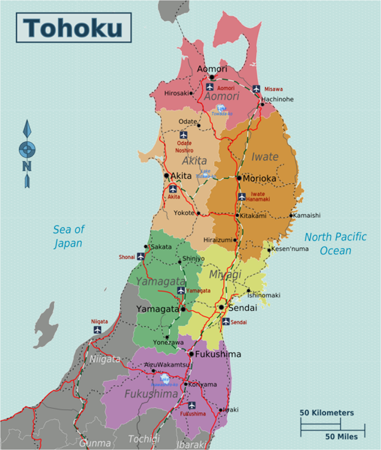The main Japanese island of Honshu is divided into five regions, which are (moving from west to east), Chugoku, where Hiroshima is located; the oddly-named Kinki region, more commonly known as Kansai, where Kyoto, Kobe and Osaka sit; Chubu in the middle, with Nagoya as the major urban center; Kanto, the large plain holding Tokyo, Yokohama and J-List’s home prefecture of Gunma; and Tohoku (lit. “east-north”), the sprawling region above Tokyo. It’s the Tohoku region that’s seen the majority of sadness from the Great Eastern Japan Earthquake (as it’s been officially named), with most of the dead and displaced located here. Since this part of Japan was likely unknown to most people before this tragedy, I thought I’d talk a little bit about it.Back during my bachelor days I saw quite a lot of Japan, and hitchhiked or took the train up to the Tohoku area many times, in part because it was relatively close by (just a couple hours from Gunma), and also because I’ve always been fascinated with enka, (iTunes Japan link), the “country music” of Japan. Just as country & western was born in the American south, enka is closely associated with the less urbanized Tohoku region, and I always loved these eerily beautiful sad songs. The Tohoku region was the domain of the Ainu, the aboriginal inhabitants of Japan, who were slowly absorbed as the “Yamato” Japanese civilization spread northward from Kyoto. The Ainu left their mark mainly on the accents of the region (they’re among the most colorful in Japan, and darned difficult for me to understand) and in place names that sound strange to the ear, written with kanji characters no one from Tokyo can read. I spent my first Japanese Christmas in Sendai (being from San Diego, I wanted to go somewhere where I could see snow), and was very impressed with the efficient, bustling provincial city of 1 million people, especially with its straight, wide streets. (I would later learn that Japanese cities with wide streets indicates cities that were heavily bombed during World War II, while cities that avoided large-scale bombing have narrow, inconvenient streets today.) The city of Sendai was founded by one of the most enigmatic characters in Japanese history, Masamune Date (dah-tay), the one-eyed samurai lord who was fascinated with Western technology, built Japan’s first Western-style sailing ship, sent a trade delegation to Rome via Mexico, and provided the inspiration for a character you might have heard of named Darth Vader. I can’t wait to see how awesome the city is once it gets back on its feet!

Some information on the Tohoku region of Japan.














